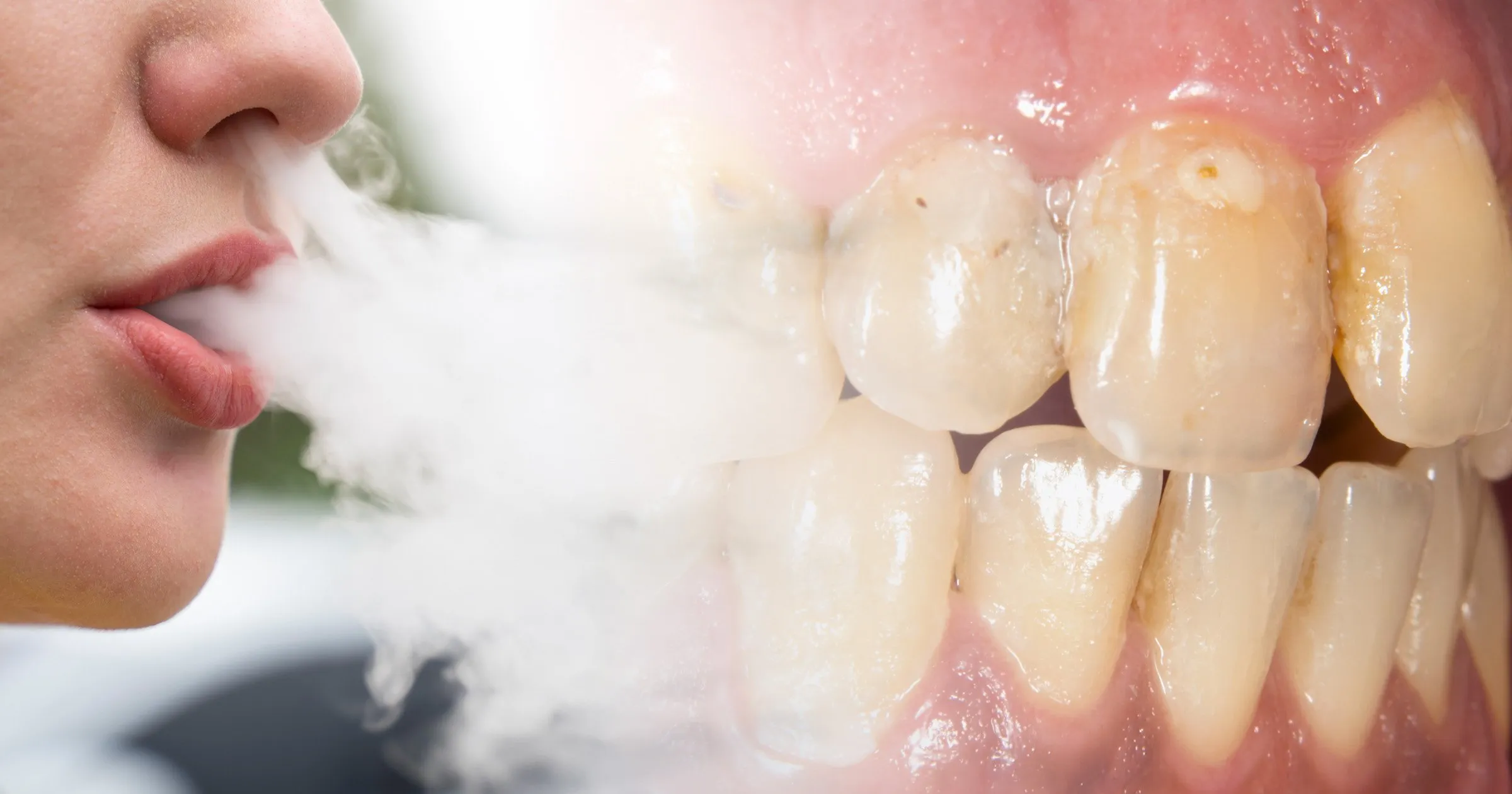
Smoking discolors teeth quickly. Tar and nicotine stick to surfaces. Enamel absorbs pigment. Stains grow darker with repetition. Whitening toothpastes scrape lightly. But pigments sink deeper. Brushing becomes less effective. Color shifts from yellow to brown. Long-term change becomes permanent.
Saliva flow decreases, reducing natural cleaning and buffering capacity
Smoke dries the mouth. Saliva reduces. Its job—neutralizing acids and washing debris—fades. Plaque builds faster. Food stays longer. Bacteria grow unchecked. Dryness increases decay risk. Gums lose hydration. The system breaks quietly before pain arrives.
Plaque hardens faster around nicotine-exposed surfaces
Smoking alters plaque composition. Sticky layers grow denser. Toxins accelerate mineralization. Tartar forms sooner. Brushing can’t remove it. Gums shrink back. Rough tartar scrapes tissues. Pockets deepen. Calculus spreads downward. Cleanings become more urgent—and less effective.
Gum tissue loses oxygen, delaying healing after irritation or trauma
Blood flow decreases. Capillaries shrink. Oxygen transport weakens. Inflammation persists longer. Cuts heal slowly. Surgery outcomes drop. Even flossing damage lingers. Gums stay red longer. They resist recovery. Healing timelines extend beyond normal.
Smokers often miss early signs of gum disease due to masking effects
Nicotine constricts blood vessels. Bleeding reduces—not from health, but restriction. Gums appear quiet. Inflammation hides. Pain dulls. Damage spreads silently. Pockets deepen unnoticed. By the time it’s visible, loss has occurred.
Periodontal disease progresses faster and resists treatment in smokers
Gum disease grows rapidly under smoke exposure. Immune cells slow. Bacterial colonies grow complex. Treatment shows less improvement. Recurrence increases. Surgery fails more often. Maintenance becomes lifelong. Recovery stays partial.
Nicotine suppresses immune responses inside the oral environment
White blood cells lose function. Inflammation becomes chronic. Infection persists longer. The body underreacts. Healing delays. Cells meant to fight stop responding. Damage deepens without resistance. Defense fades under chemical pressure.
Bone supporting the teeth recedes faster under tobacco exposure
The jawbone shrinks beneath infected gums. Smoking accelerates loss. Teeth loosen. X-rays show darkness. Support fades quietly. Bridges and implants become impossible. Dentures become the only solution. Bone doesn’t regenerate easily.
Dental implants fail more often in smokers than nonsmokers
Implants rely on bone integration. Smoking disrupts this bond. Healing slows. Infections rise. Rejection increases. Some dentists delay placement. Others refuse entirely. Success drops by half. Investment risks rise under smoke exposure.
Smoking reduces blood flow in tiny oral capillaries
Tiny vessels feed gum tissue. Smoke constricts them. Oxygen drops. Waste accumulates. Tissues starve. Gums retract. Color fades from pink to pale. Infection stays longer. Pain arrives late—but deeper.
Nicotine exposure alters bacterial balance in the mouth
Normal flora shifts. Harmful strains dominate. Biofilms thicken. Balance breaks. Friendly bacteria decline. Acidic byproducts rise. pH drops. Decay begins where it never did. Smell worsens. Tongue coatings grow. Gums burn longer.
Cigarette smoke changes taste perception over time
Taste buds dull. Food becomes less distinct. Smoke layers coat the tongue. Salty and sweet fade. Smokers eat differently. Cravings shift. Flavors flatten. Recovery takes weeks after quitting. Some buds don’t return fully.
Mouth ulcers heal slower and reappear more frequently in smokers
Ulcers sting longer under nicotine. Healing stretches. Recurrent sores become common. Smokers normalize pain. Lesions persist. Gums redden around the base. Lingering ulcers suggest deeper breakdown.
Dry socket risk increases significantly after tooth extraction
Blood clots dislodge more easily in smokers. The socket dries. Bone becomes exposed. Pain intensifies. Healing stalls. Smoke chemicals reach the wound. Every puff delays closure. Dentists warn strongly. Some refuse extraction unless patients abstain.
Halitosis from smoking doesn’t fade with brushing alone
Smoke embeds in tissue. The tongue absorbs smell. Brushing removes little. Gases return quickly. Mints mask briefly. Smell lingers deep. Chronic bad breath often resists treatment until smoking stops.
Whitening treatments work slower and wear enamel faster in smokers
Bleaching agents remove surface stains. But smoke resists lifting. Whitening takes longer. Enamel thins. Sensitivity grows. Results fade fast. Stains return. Color brightens briefly—then darkens again. Smoking undoes progress quickly.
Oral cancer risk multiplies with each year of continued tobacco use
Cells mutate under heat and chemical stress. Lesions appear. Red or white patches persist. Biopsies follow. Some remain benign. Others don’t. Cancers spread fast in oral tissues. Gums, tongue, palate—all vulnerable. Screening becomes routine.
Smokeless tobacco causes deep recession and localized decay
Dip and snuff rest in one spot. Chemicals soak tissue. Gums pull back. Teeth erode beneath. Cavities start low. Bone loss follows. Even without smoke, damage runs deep. Position determines harm—but no site stays safe.
Teeth exposed to heat cycles become more brittle over time
Temperature swings stress enamel. Hot smoke. Cold drinks. Cracks form. Microfractures spread. Chips happen easier. Pressure from chewing worsens breaks. Teeth weaken slowly. Crowns become common. Fillings fail faster.
Veneers and bonding discolor faster on smokers’ teeth
Restorations stain unevenly. Edges darken. Material loses polish. Bright smiles dull. Cosmetic work fails early. Maintenance costs rise. Whitening won’t work. Only replacement restores appearance.
Gums appear darker due to melanin response to tobacco
Melanosis develops with exposure. Gums darken—especially in anterior areas. Not all smokers see it. Some do. It isn’t disease—but it signals reaction. The color fades after quitting. Slowly.
Pregnancy and smoking multiply oral health risks for both parent and fetus
Pregnancy increases gum sensitivity. Smoking worsens inflammation. Risk doubles. Bleeding rises. Growth factors change. Development suffers. Oral infections link to birth complications. Dentists monitor more closely.
Braces work slower and carry higher complication rates in smokers
Tooth movement relies on bone turnover. Smoking slows this process. Braces take longer. Gums inflame more. White spots form around brackets. Wires irritate more. Orthodontists warn early.
Gum grafts in smokers have higher failure rates post-surgery
Tissue transfer needs blood flow. Smoking restricts supply. Grafts shrink or die. Surgeons hesitate. Recovery includes strict abstinence. Even one cigarette delays healing. Results decline quickly.
